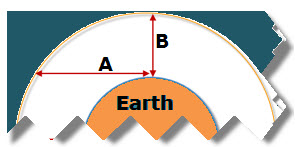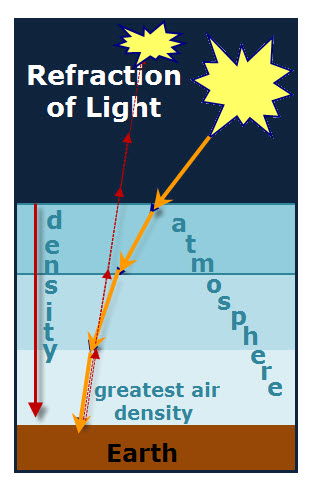Science Project Idea |
|||||||||
|---|---|---|---|---|---|---|---|---|---|
Why Do Stars Twinkle? |
|||||||||
Facts |
What Do You Want to Find Out? |
||||||||
| Stars appear to twinkle because star-light refracts as it passes through Earth’s atmosphere.
|
1. What is light refraction? 2. What causes the star-light to refract? 3. Does the angle of the light affect how it might refract? 4. What characteristic about Earth’s atmosphere 5. causes star-light to refract? |
||||||||
| Light refracts when it passes through materials with different densities. | How does density affect the direction of light? | ||||||||
Experimental Clue:Liquids could be used to determine how light refracts when it passes through materials with different densities. |
|||||||||
RESEARCH: Stellar Scintillation
The scientific name for the twinkling of stars is stellar scintillation.
The Earth’s atmosphere is a mixture of gases called air. These gases decrease in density as the atmosphere extends from the Earth’s surface out into space.
The density of air is the measure of the amount of air particles in a certain volume. The air layer next to Earth’s surface has the greatest density, thus the air concentration is greatest in this bottom layer. The farther from the Earth’s surface, the less concentrated is air, thus the lower is the density of air.
Light travels in a straight line as long as it is traveling through material with a constant density.
As this light passes from one density layer of air into the next, the light is refracted, which means its direction changes. In the diagram, one beam of starlight is shown to refract (change direction) as it enters a layer with a different density. This happens again and again until the beam of light reaches Earth’s surfaces.
The red dashed line indicates where you perceive the source of this refracted beam to be. This line is straight, but the actually light ray is not straight because it has been refracted.
Every ray of light from a star that enters the Earth’s atmosphere at an angle is refracted, which results in the star winking out.
Winking Out means that each refracted ray of star light perceived as being in a different place in the sky. In other words, each refracted light ray appears as though the star has moved a tiny distance. Since the rays of star light come from many different direction, your eyes receive this light and send the messages to your brain. It is in your brain where the interpretation that the star is blinking –twinkling–is made.
 The density of air in one atmospheric layer is not the same throughout. Wind in the lower level as well as pollutants cause light to be refracted.
The density of air in one atmospheric layer is not the same throughout. Wind in the lower level as well as pollutants cause light to be refracted.
Stars that appear closer to the horizon appear to twinkle more than do stars seen overhead. This is because the light from stars near the horizon travels through more air than does the light of stars overhead, thus there is more refraction–more twinkling.
Why doesn’t moonlight or light from planets twinkle?
Planets generally do not appear to twinkle.
First of all, the light from planets is reflected sunlight. Even so, this light also passes through layers of gas in Earth’s atmosphere. Since planets are so much closer to Earth than are stars, they appear to be much larger than stars.
Yes, like from planets as well as the Moon refracts as it passes through the atmosphere, but since the Moon and planets appear so much lar is so large and the twinkling is so slight that it is not noticeable.
Stars do not appear to twinkle when viewed from the Moon because the Moon doesn’t have an atmosphere surrounding it.
